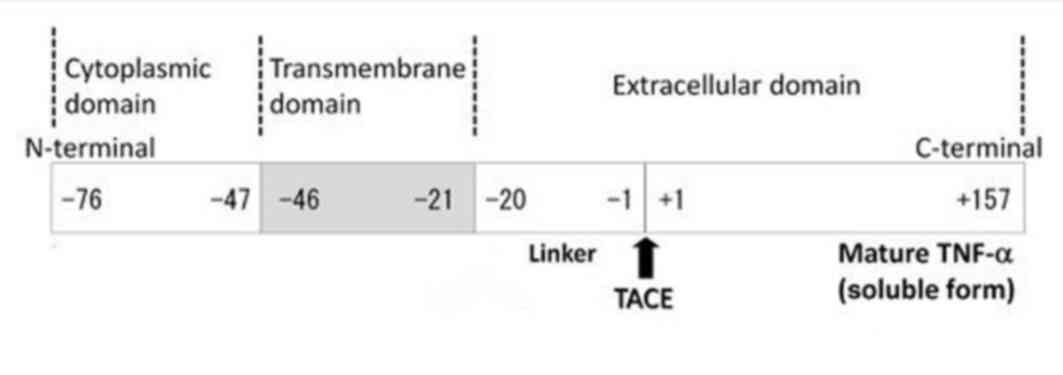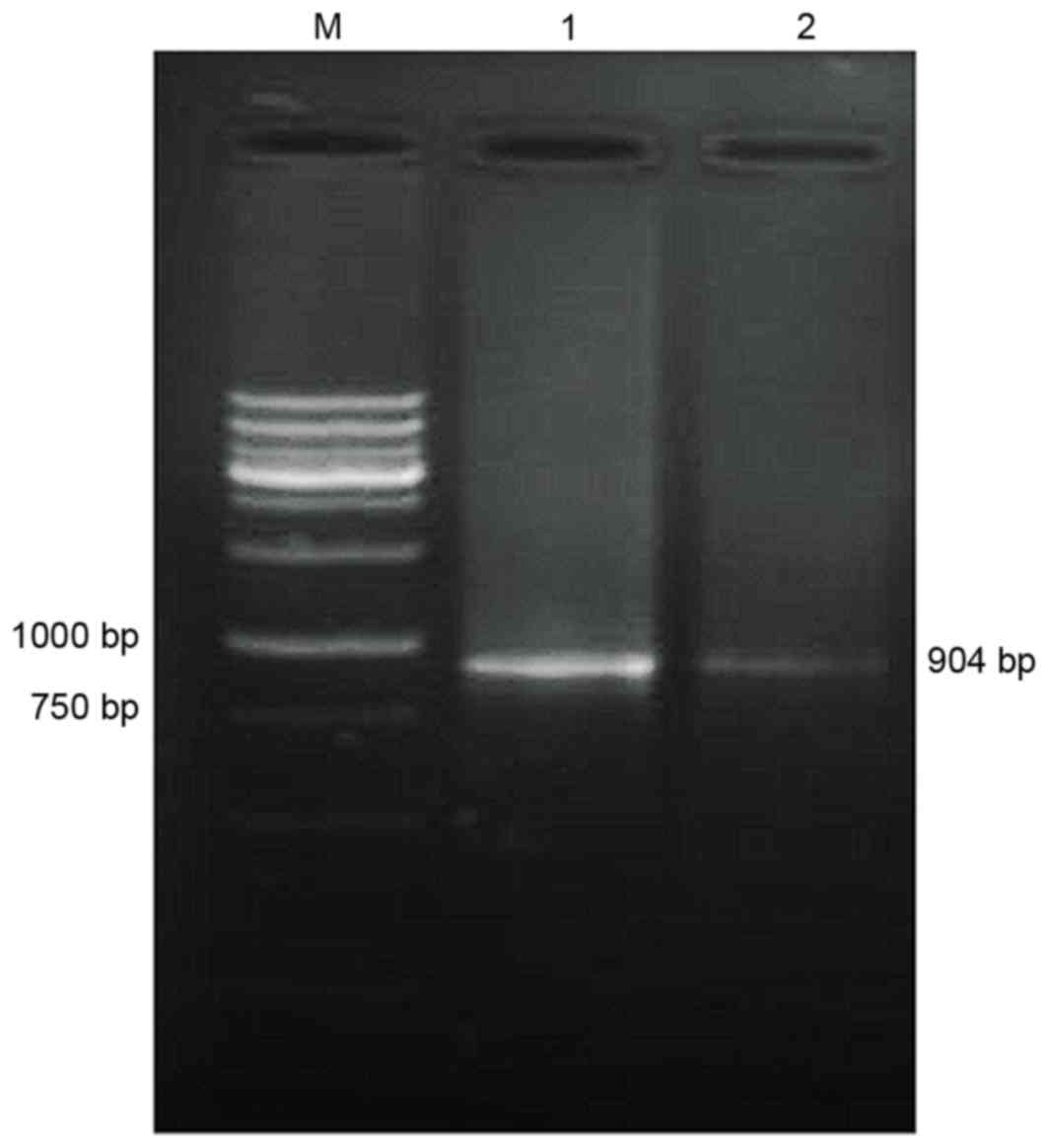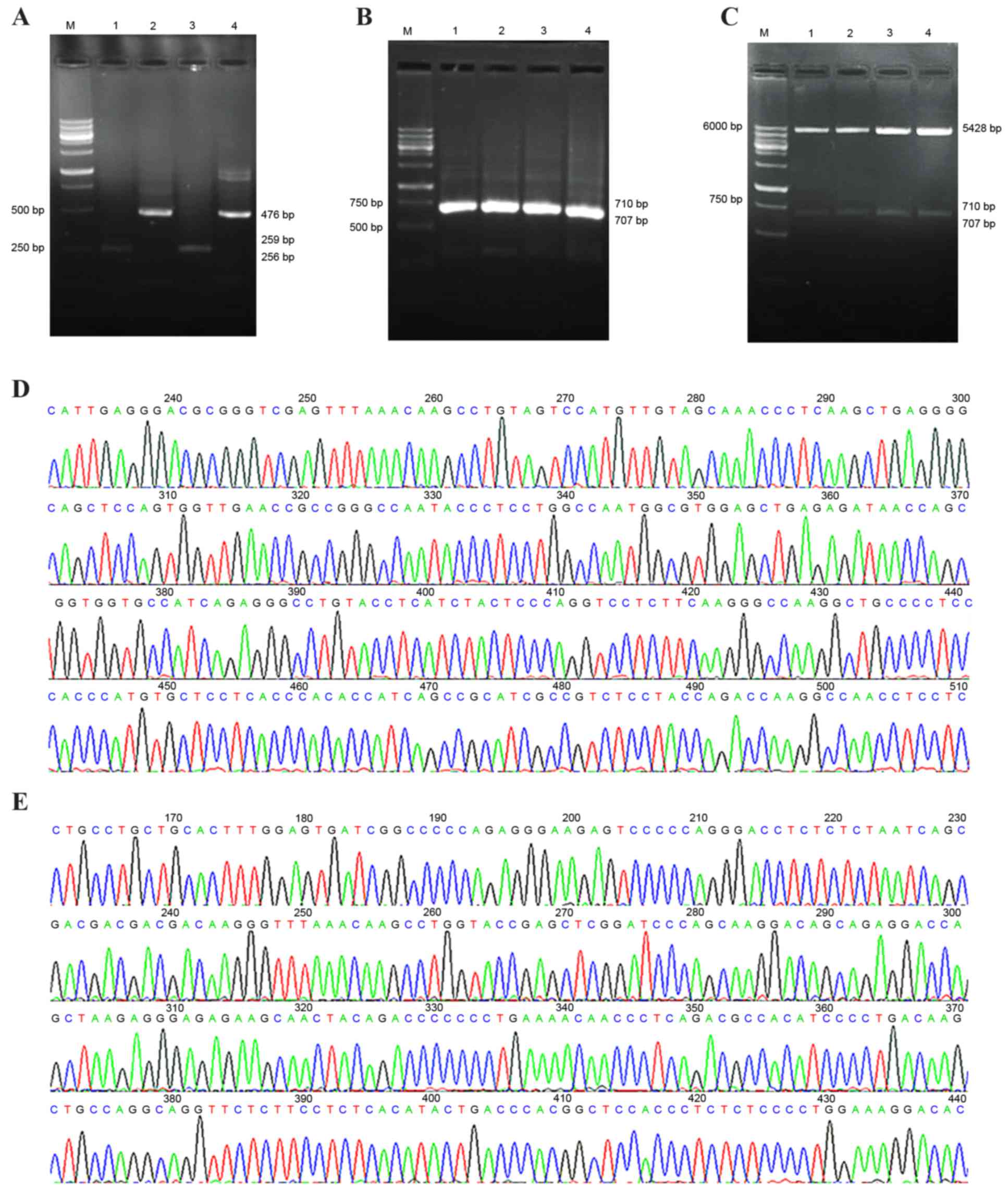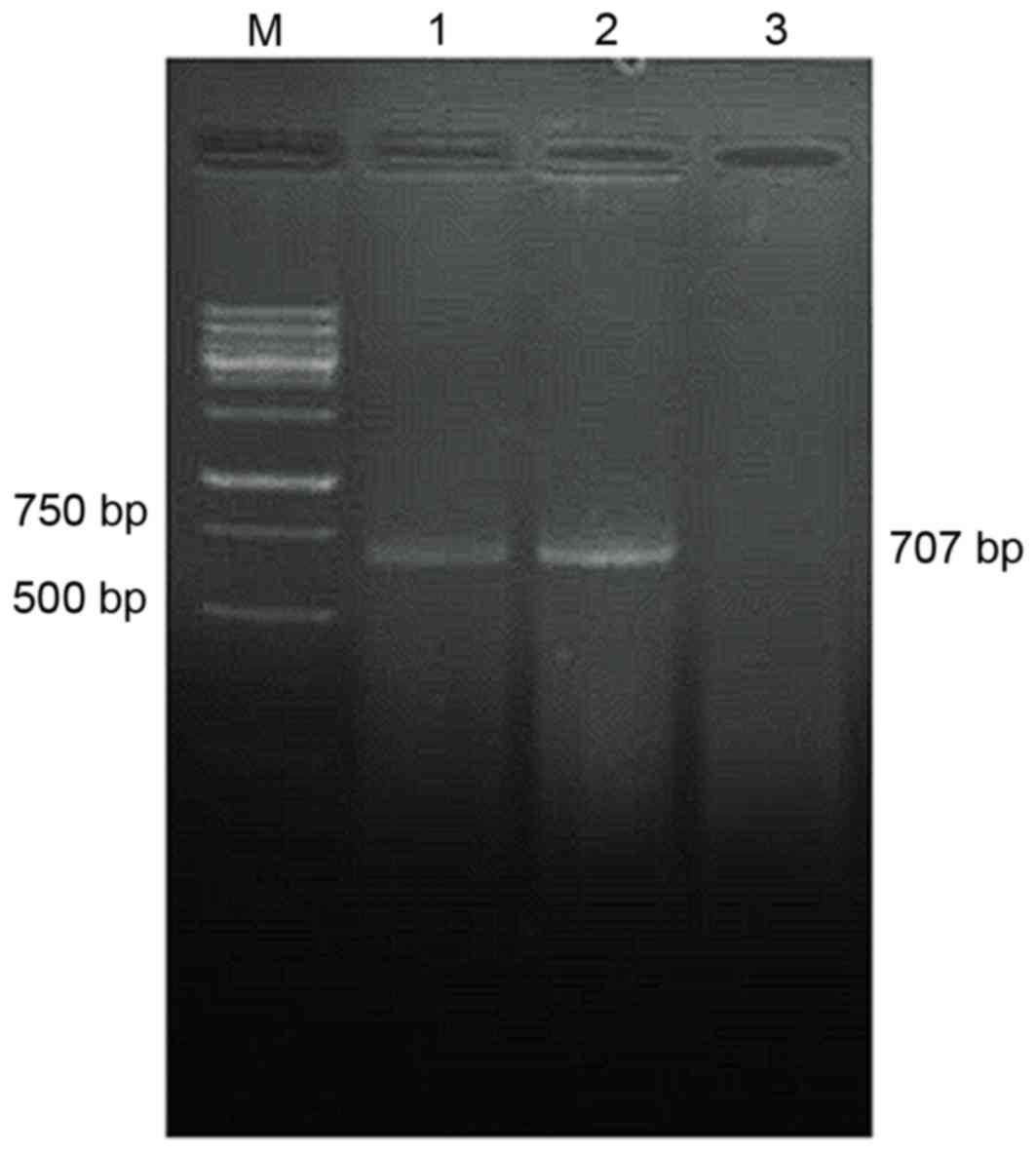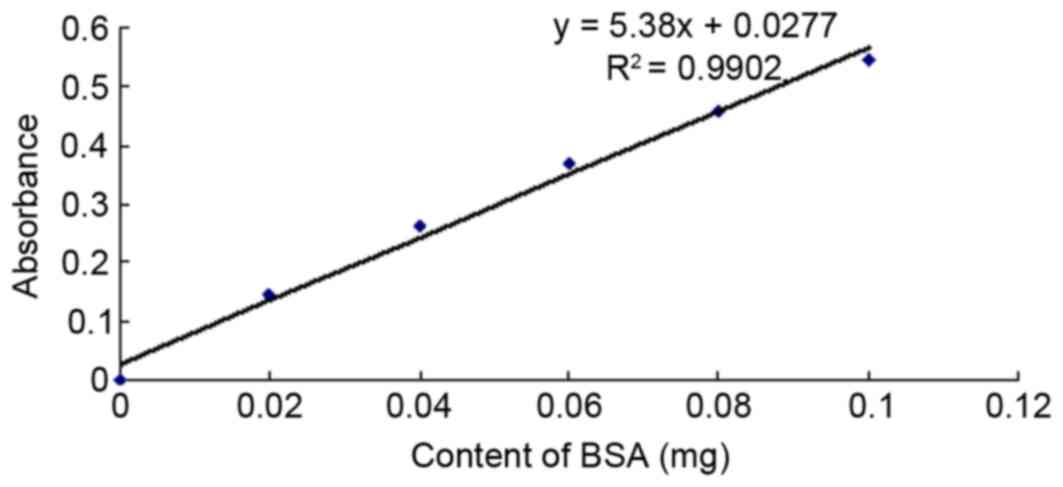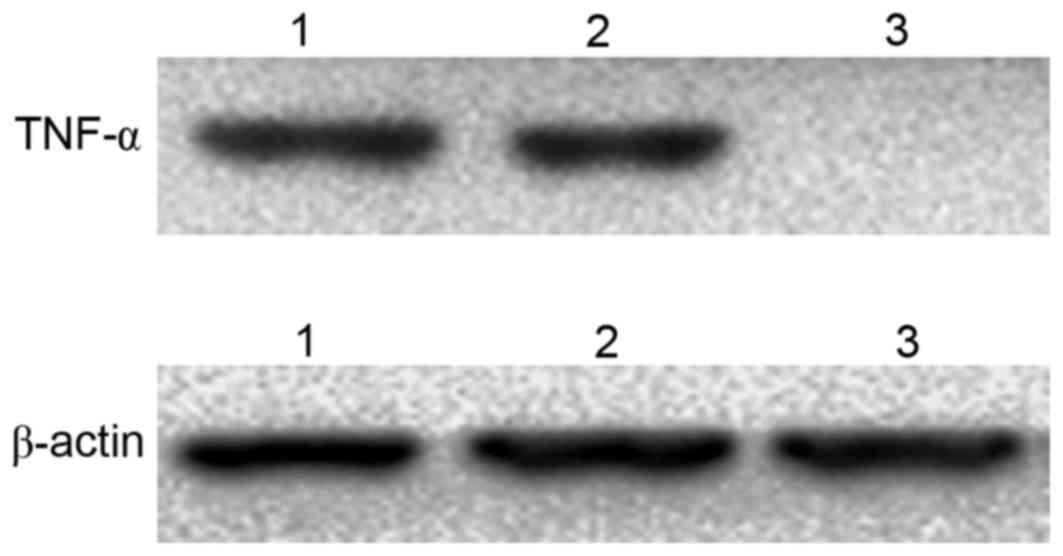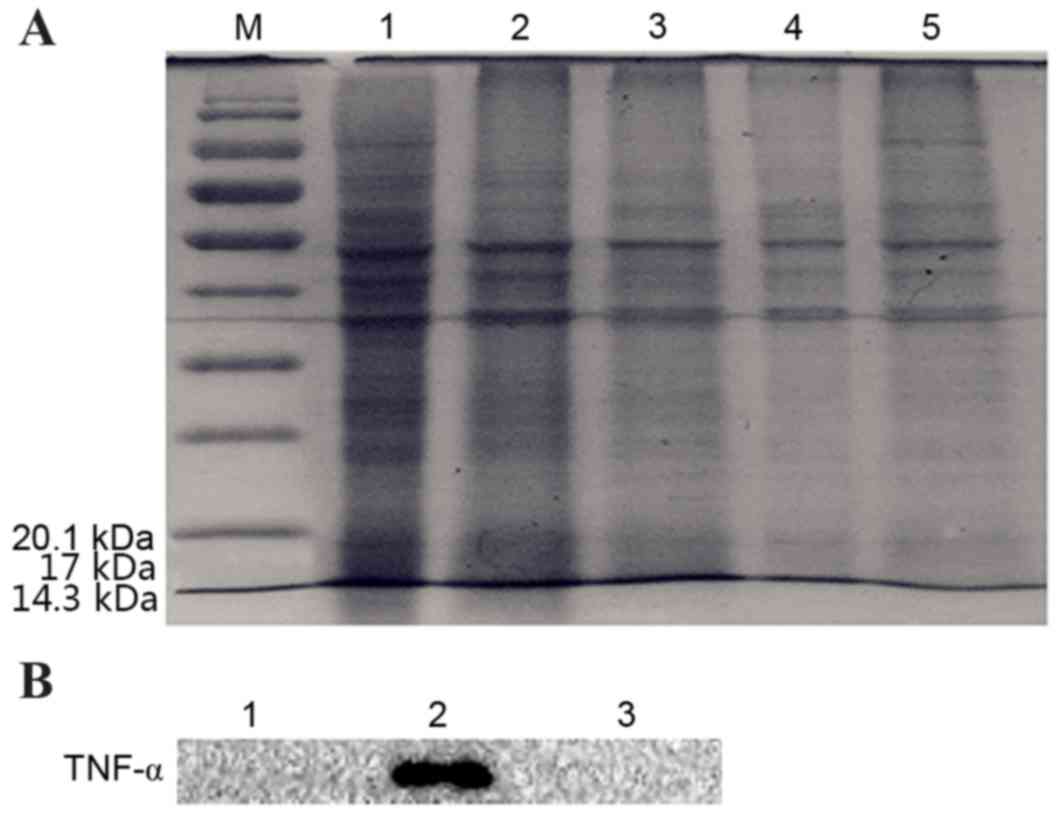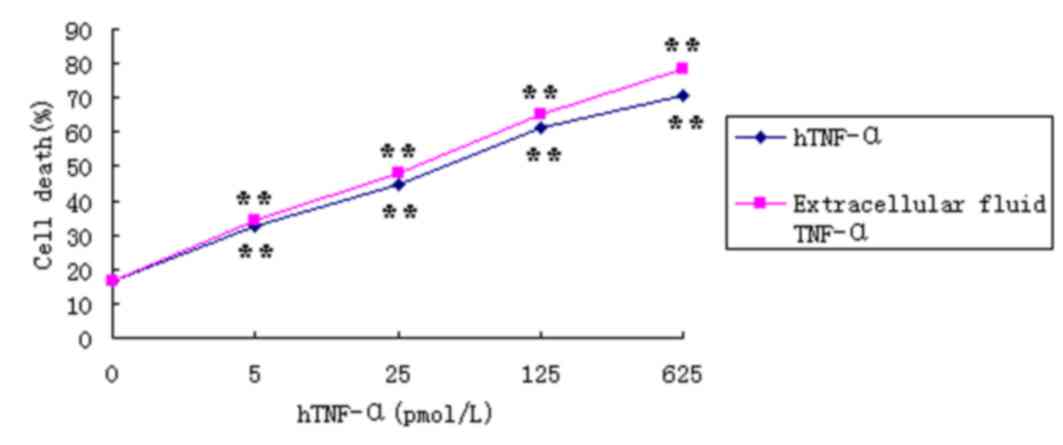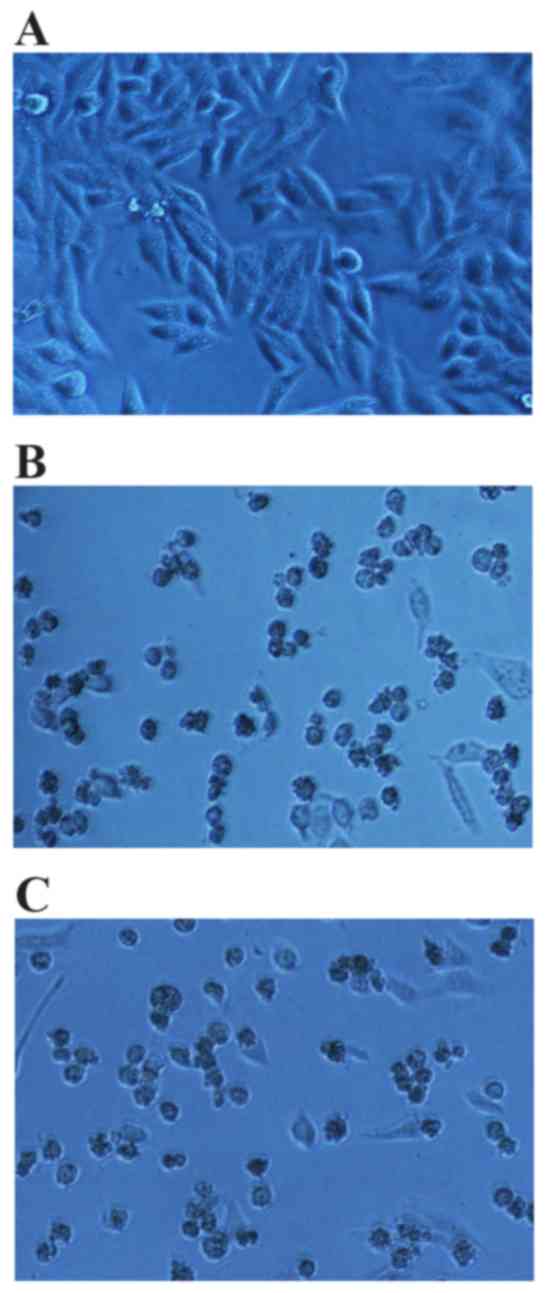Construction and characterization of a transmembrane eukaryotic expression vector based on the membrane domain structure of TNF-α
- Authors:
- Published online on: June 6, 2017 https://doi.org/10.3892/mmr.2017.6692
- Pages: 1021-1030
-
Copyright: © Wang et al. This is an open access article distributed under the terms of Creative Commons Attribution License.
Abstract
Introduction
Tumor necrosis factor (TNF)-α is a 17-kDa oligomeric glycoprotein, which is primarily stimulated by lipopolysaccharides (LPS) (1,2). TNF-α exists in two forms, transmembrane-TNF-α (TM-TNF-α) and soluble (s)-TNF-α (3,4). TM-TNF-α is the precursor to s-TNF-α, and its primary structure consists of 233 amino acid residues, where −76 to −1 amino acids comprises a leader peptide sequence, −1 to −20 is a linkage segment and −21 to −46 is a hydrophobic region (5,6). These sequences comprise the transmembrane segment, whilst the remainder of the sequence forms the intracellular domain. Under the effect of the metalloproteinase, tumor necrosis factor-α converting enzyme, TM-TNF-α extracellular segments 1 to 157 can be hydrolyzed (Fig. 1). This leads to TM-TNF-α removal and transformation into s-TNF-α (7–9). Initially TNF-α is expressed as a membrane protein, and then following the removal of the extracellular segment by metalloproteinase, it is transformed into s-TNF-α. This process requires hydrophobic transmembrane domains in the target protein to determine transmembrane structure, as well as signaling peptides to mediate the transport of proteins across the transmembrane. This process is based on a supported signaling hypothesis (10), whereby the peptide, initially translated by the mRNA signal sequence in the cytoplasm, is recognized by the signal recognition particle (SRP), which presents the signaling peptide recognition site, the translation termination site and the SRP receptor recognition site. SRP then recognizes the signaling peptide, which leads to termination of mRNA translation. SRP subsequently combines with the SRP receptor, also known as the docking protein (DP), which is located on the endoplasmic reticulum. SRP then binds guanosine 5′-triphosphate (GTP) at the GTP catalytic site and transfers the mRNA to a channel protein known as translocon, which resides in the endoplasmic reticulum in synergy with DP. mRNA is then transferred to the endoplasmic reticulum for co-translation. There are two types of signal generated by this mRNA; the start transfer membrane-anchor sequence and stop transfer membrane-anchor sequence. When the stop transfer membrane-anchor sequence signal is generated, mRNA remains on the surface of the endoplasmic reticulum without entering, and produces transmembrane proteins during translation (10). The start transfer membrane-anchor sequence signal induces mRNA to enter the endoplasmic reticulum and produce multiple transmembrane proteins following translation (11).
The aim of the present study was to design a eukaryotic expression vector based on the transformation of TM-TNF-α into s-TNF-α, which allowed for the hydrolyzation of membrane fusion proteins in a controlled manner. The sequence of mRNA encoding the extracellular segment of TM-TNF-α was processed using enterokinase and FactorXa, and TNF-α mRNA was then inserted using guiding peptides. The whole recombinant RNA was inserted into the eukaryotic expression vector pcDNA3.1(+) thus generating a novel recombinant plasmid. The plasmid was subsequently transfected into mouse fibroblasts, in order to produce a membrane protein with an extracellular segment of TNF-α containing a protease cleavage site in the middle linker region, which was processed with corresponding enzymes. The target protein was then obtained using digestive enzyme solutions.
Materials and methods
Materials
Escherichia coli (E. coli) DH5α, E. coli JM109, pcDNA3.1(+), s-TNF-α cDNA, mouse fibroblast cells (L929) and mouse embryonic fibroblasts (3T3 cell) were provided by the laboratory of the Guangdong Medical College Institute (Guangdong, China), and the human early immature myeloid leukemia cell line (HL-60) was donated by Professor Yu Lijian (Guangdong Ocean University, Zhanjiang, Guangdong, China). RPMI-1640, Dulbecco's modified Eagle's medium (DMEM) and the Lipofectamine™ 2000 transfection reagent were purchased from Invitrogen; Thermo Fisher Scientific, Inc. (Waltham, MA, USA). Fetal bovine serum (FBS) was purchased from Hangzhou Sijiqing Biological Engineering Materials Co., Ltd. (Hangzhou, China). Goat anti-mouse IgG-horseradish peroxidase (HRP) antibody (Santa Cruz Biotechnology, Inc., Dallas, TX, USA; cat. no. SC-2005; 200 µg/0.5 ml) was purchased online from univ-bio (http://univ.univ-bio.com/; owned by Shanghai You Ningwei Biotechnology Co., Ltd., Shanghai, China). Mouse anti-human TNF-α was purchased from BD Biosciences (Franklin Lakes, NJ, USA). All other chemicals used in this study were national analytical reagents. The gel imaging analysis system, Molecular Imager (ChemiDoc™ XRS+), polymerase chain reaction (PCR) instrument (PTC200 PCR Thermal Cycler), vertical electrophoresis and electrophoresis apparatus were purchased from Bio-Rad Laboratories, Inc. (Hercules, CA, USA).
Acquisition of transmembrane TNF-α cDNA
The expression of TM-TNF-α in human HL-60 promyelocytic leukemia cells was induced by treating cells with phorbol ester (100 ng/ml) and LPS (100 ng/ml; Beijing LEYBOLD Cable Technology Co., Ltd., Beijing, China) (12,13). Total RNA was isolated from HL-60 cells (2×106/ml) using TRIzol reagent (Invitrogen; Thermo Fisher Scientific, Inc.), according to the manufacturer's recommendations. Using a reverse transcription (RT)-PCR kit (Takara Bio Inc., Otsu, Japan), total RNA was reverse transcribed to TM-TNF-α cDNA. The reaction conditions were as follows: Initial denaturation at 50°C for 30 min, followed by 30 cycles of denaturation at 94°C for 2 min, 94°C for 15 sec and 68°C for 30 sec, then a final extension at 72°C for 10 min. The TM-TNF -α gene was amplified using the following primers (reference sequence, NM_000594.2, https://www.ncbi.nlm.nih.gov/nuccore/25952110): Sense primer 5′-CGCGGATCCCAGCAAGGACAGCAGAGGACCAG-3′, and anti-sense primer 5′-CCGGAATTCGAGGCGTTTGGGAAGGTTGGA−3′. The PCR product (904 bp) contained a BamHI restriction site and, downstream of the amplified DNA fragment, an EcoRI restriction site (New England Biolabs Ltd., Beijing, China). PCR products were detected by 2% agarose gel electrophoresis (Gene Tech Biotechnology Co., Ltd., Shanghai, China).
Construction of pcDNA3.1-TM-enterokinase-TNF-α and pcDNA3.1-TM-FactorXa-TNF-α plasmid vectors
NHeI, PmeI and EcoRI restriction enzymes were purchased from New England Biolabs Ltd. According to the primer design guidelines (Generay Biotech Co., Ltd., Shanghai, China), the enterokinase primer sequences were as follows: Sense primer (5′ add the NheI restriction site to cDNA, 162–186 nucleotides), 5′-CGGCTAGCAAGGACACCATGAGCACTGAAAGC-3′, anti-sense primer, (5′ add the enterokinase and PmeI restriction site to cDNA, 361–385 nucleotides), 5′-GCGTTTAAACCCTTGTCGTCGTCGTCGCTGATTAGAGAGAGGTCC-3′.
The enterokinase coding region insertion fragment was 256 bp in length, and the sequence was as follows: 5′-CGGCTAGCAAGGACACCATGAGCACTGAAAGCATGATCCGGGACGTGGAGCTGGCCGAGGAGGCGCTCCCCAAGAAGACAGGGGGGCCCCAGGGCTCCAGGCGGTGCTTGTTCCTCAGCCTCTTCTCCTTCCTGATCGTGGCAGGCGCCACCACGCTCTTCTGCCTGCTGCACTTTGGAGTGATCGGCCCCCAGAGGGAAGAGTTCCCCAGGGACCTCTCTCTAATCAGCGACGACGACGACAAGGGTTTAAACGC-3′. The primer sequences for FactorXa were as follows: Sense primer (5′ add the NheI restriction site to cDNA, 162–186 nucleotides), 5′-CGGCTAGCAAGGACACCATGAGCACTGAAAGC−3′, anti-sense primer (5′ add the enterokinase and PmeI restriction site to cDNA, 361–385 nucleotides), 5′-GCGTTTAAACTCGACCCGCGTCCCTCAATGCTGATTAGAGAGAGGTCC−3′. The FactorXa coding region insertion fragment was 259 bp in length and the sequence was as follows: 5′-CGGCTAGCAAGGACACCATGAGCACTGAAAGCATGATCCGGGACGTGGAGCTGGCCGAGGAGGCGCTCCCCAAGAAGACAGGGGGGCCCCAGGGCTCCAGGCGGTGCTTGTTCCTCAGCCTCTTCTCCTTCCTGATCGTGGCAGGCGCCACCACGCTCTTCTGCCTGCTGCACTTTGGAGTGATCGGCCCCCAGAGGGAAGAGTTCCCCAGGGACCTCTCTCTAATCAGCATTGAGGGACGCGGGTCGAGTTTAAACGC-3′.
Using TM-TNF-α cDNA as a template and the aforementioned primers, PCR was performed as follows: Hot start at 98°C for 2 min followed by 30 cycles of denaturation at 98°C for 15 sec, annealing at 68°C for 30 sec, and a final extension step for at 72°C 10 min. The final holding temperature was 4°C.
The transmembrane region sequence was then annealed to the enterokinase restriction site and s-TNF-α (700 bp in length), using the following primer sequences: Fragment 1A primer (amplicon length, 246 bp), E1 upstream, 5′-CGGCTAGCAAGGACACCATGAGCACTGAAAGC-3′ (5′ add the NheI restriction site), and E1 downstream, 5′-CCTTGTCGTCGTCGTCGCTGATTAGAGAGAGGTCCCTGGGGGACTCTTCC-3′; fragment 2A primer (amplicon length, 473 bp), TNF -α upstream, 5′-CTAATCAGCGACGACGACGACAAGGGTTTAAACAAGCCTG-3′, and TNF -α downstream, 5′-CGCGAATTCTCACAGGGCAATGATCCCAAAG-3′ (5′ add the EcoRI restriction site).
The sequence of transmembrane region was then annealed to the FactorXa restriction site and s-TNF -α (706 bp in length) using the following primer sequences: Fragment 1B primer, (amplicon length, 245 bp), F1 upstream, 5′-CGGCTAGCAAGGACACCATGAGCACTGAAAGC-3′ (5′ add the NheI restriction site), and F1 downstream, 5′-CCCGCGTCCCTCAATGCTGATTAGAGAGAGGTCCCTGGGGGACTCTTCC-3′; fragment 2B primer (amplicon length, 489 bp), TNF-α upstream, 5′-CTAATCAGCATTGAGGGACGCGGGTCGAGTTTAAACAAGCCTG-3′, and TNF -α downstream, 5′-CGCGAATTCTCACAGGGCAATGATCCCAAAG-3′ (3′ add the EcoRI restriction site).
Using the TNF -α transmembrane segment plasmid and s-TNF-α plasmid as a template together with the associated primers, the fragment was connected by overlap extension PCR. The overlap extension PCR was performed by incubating samples at 95°C for 5 min and 72°C for 10 min.
PCR products were digested with EcoRI and BamHI before they were cloned into the corresponding restriction sites in the pcDNA3.1 vector to generate the pcDNA3.1-TM-enterokinase-TNF-α and pcDNA3.1-TM-FactorXa-TNF-α plasmids for expression. The ligation products were transformed into chemocompetent E. coli DH5a cells (E. coli DH5a cells treated by precooled 0.1 mol/l CaCl2) maintained in LB medium (Shanghai Kehua Bio-Engineering Co., Ltd., Shanghai, China) and bacterial culture medium containing ampicillin (100 µg/ml; Tiangen Biotech Co., Ltd., Beijing, China), before cultures were incubated at 37°C for 12 to 16 h in inverted culture. To select for the recombinant plasmid-positive colonies, 1% agarose gel electrophoresis was performed, followed by DNA sequencing (sequenced by Sangon Biotech Co., Ltd., Shanghai, China).
Transfection of 3T3 cells
3T3 cells were seeded into a 60-mm culture dish at a density of 1×106 cell/dish at 12 h prior to DNA transfection. A total of 2.5 µg DNA plasmids were diluted in 125 µl opti-MEM medium (Invitrogen; Thermo Fisher Scientific, Inc.), and Lipofectamine™ 2000 transfection reagent was used to transfect 3T3 cells with plasmid DNA. Following 5 min, the diluted plasmid DNA and Lipofectamine™ 2000 were mixed together and incubated at room temperature for 20 min. The mixture was then added to each dish and incubated at 37°C in a 5% CO2 incubator for 5 h. Non-transfected 3T3 cells were the control group. Following incubation, the media was replaced with DMEM (Invitrogen; Thermo Fisher Scientific, Inc.), supplemented with 10% FBS (Hangzhou Sijiqing Biological Engineering Materials Co., Ltd.).
Analysis of the expression of TNF-α RNA
Total cellular RNA was isolated using Trizol reagent (Invitrogen; Thermo Fisher Scientific, Inc.) in 3T3 cells following 48 h of transfection, according to the manufacturer's recommendations. All processes were conducted in a sterile and ribonuclease-free environment. Isolated RNA was dissolved in nuclease-free water and stored at −20°C. RT-PCR was performed using FastQuant cDNA first strand synthesis kit (Tiangen Biotech Co., Ltd., Beijing, China) using total RNA (1 µg) for 5 min at 42°C. The cDNA samples from RT reactions were amplified using 2X Taq PCR MasterMix (Tiangen Biotech Co., Ltd.) and the following primers: Sense, 5′-GGACGCGGGTCGAGTTTAAACAAGCCTG-3′, and anti-sense, 5′-CGAATTCTCACAGGGCAATGATCCC-3′. Thermal cycling conditions were as follows: Incubation at 50°C for 30 min and 94°C for 2 min, followed by 30 cycles of 94°C for 15 sec, 68°C for 30 sec and extension at 72°C for 10 min. The PCR products were loaded onto a 1% agarose gel containing SYBR® Safe DNA Gel Stain (Thermo Fisher Scientific, Inc.) for electrophoresis at 100 V for 40 min. The gel was then analyzed and photographed using the BIO-RAD Gel Doc XR + (Bio-Rad Laboratories, Inc.).
Detection of TNF-α expression in total protein cell lysates by western blotting
Following incubation of transfected cells for 24 h, total protein was extracted using a mixture of 1% protease inhibitors (Merck KGaA, Darmstadt, Germany) and 1% phenylmethylsulfonyl fluoride (Beyotime Institute of Biotechnology, Haimen, China) in radioimmunoprecipitation lysis buffer (Beyotime Biotechnology Co, Shanghai, China). Protein concentration was determined using a Bradford Protein assay kit (Bi Yuntian Biological Technology Institution, Shanghai, China). Proteins were separated on 10 and 5% SDS-PAGE gels and transferred to a nitrocellulose filter membrane. The membranes were blocked with 5% non-fat milk in phosphate-buffered saline containing Tween-20 (PBST) for 2 h at room temperature, and were subsequently incubated with mouse anti-human TNF-α antibody (cat. no. 551220; dilution, 1:1,000 in Primary Antibody Dilution Buffer; Beyotime Institute of Biotechnology) overnight at 4°C. Following three washes with PBST, the membrane was then incubated with goat anti-mouse IgG-HRP antibody (cat. no. sc-2005; dilution, 1:1,000 in Primary Antibody Dilution Buffer; Beyotime Institute of Biotechnology) for 1 h at room temperature. In the same manner, the membrane was incubated with the primary antibody β-Actin (1:1,000; cat. no. 8H10D10; mouse monoclonal antibody; Cell Signaling Technology, Inc., Danvers, MA, USA) and then the secondary antibody, goat anti-mouse IgG-HRP, to determine the β-actin protein expression to be used as an internal control. Protein bands were visualized using BeyoECL Plus electro-chemiluminescence reagent (Beyotime Institute of Biotechnology), following exposure to X-ray film.
Detection of TNF-α in extracellular digestion mixtures
Following transfection with pcDNA3.1-TM-enterokinase-TNF-α plasmid, pcDNA3.1-TM-plasmid FactorXa-TNF-α or control (non-transfected cells) for 24 h, the media was removed cells were washed 7 or 8 times with PBS to remove additional proteins. Digestion was performed by applying enterokinase (2.5 U; GenScript, Piscataway, NJ, USA), 10X enterokinase buffer [1 M NaCl, 500 mM Tris-HCl, 50 mM CaCl2], 1X FactorXa/enterokinase Dil/Stor buffer (500 mM NaCl, 20 mM Tris-HCl, 2 mM CaCl2, 50% glycerol), FactorXa (3.5 U, Novagen, Merck KGaA); 10X Xa cleavage buffer (1 M NaCl, 500 mM Tris-HCl) and 1X Xa Dil/Stor buffer to the cells. The cells were then incubated at 22°C for 6 to 8 h. A dialysis bag was cut into small sections of appropriate length (10 to 20 cm) and the pieces were boiled in 2% (w/v) sodium bicarbonate and 1 mmol/l EDTA (pH 8.0) for 10 min. The sections were thoroughly cleaned using distilled water and were boiled again in 1 mmol/l EDTA (pH 8.0) for 10 min, and stored at 4°C; EDTA was washed away prior to use. The cell digestion mixture was then transferred to the dialysis bags and immersed in dialysis buffer (0.02 mol/l pH8.0 Tris-HCL, 0.05% Tween-20, 1 mmol/l NaN3) to allow the sample to become well dialyzed and concentrated. SDS-PAGE analysis was performed on 82×82 mm2 gels, (the percentage of propylene in the separation gel and concentrate were 12 and 5%, respectively). Electrophoresis was performed at 140 V for the separation gel and at 80 V for the concentrate gel. 0.25% Coomassie brilliant blue staining was applied at room temperature for 15 min and western blotting was performed as described in the previous section.
Preliminary study of TNF-α activity in the extracellular digestive mixture
L929 cells were used to determine the activity of TNF-α in the extracellular digestion mixture, as they are susceptible to TNF-α. L929 cells were cultured in RMPI-1640 containing 10% BSA and were incubated at 37°C with 5% CO2. The L929 cells were collected during the logarithmic growth phase following trypsin digestion (Amresco, LLC, Solon, OH, USA), and were diluted to a final concentration of 3×105 cells/ml. The cell suspension (100 µl/well) was transferred to a 96-well plate. Following 24 h of incubation, cell adhesion was complete. A total of 1 µg fresh medium and actinomycin D (Sangon Biotech Co., Ltd.) were added to the plate. An appropriate dilution of RPMI-1640 culture containing 1 µg/ml of actinomycin D was added to the corresponding well with three kinds of TNF-α [hTNF-α (Guangdong Medical College Institute, Guangdong, China), pcDNA3.1-TM-enterokinase-TNF-α extracellular digestion mixture (P1) and pcDNA3.1-TM-FactorXa-TNF-α extracellular digestion mixture (P2)], to create the concentration range of 5, 25, 125 and 625 pmol/l. Each sample had three parallel wells. A blank group was set up with only medium. Following incubation at 37°C with 5% CO2 for 24 h, 10 µl MTT work solution (concentration, 5 mg/ml) was added to each well. The plate was further incubated at 37°C for 4 h. The supernatant was then carefully aspirated and 200 µl/well DMSO was added. The final A570 was measured using an enzyme-labeled instrument after complete mixing and the death rate was calculated. The results were expressed as the mean ± standard deviation of the three-well optical density (OD) values in each group. The effect of the different concentrations of protein on the ability of proliferating tumor cells to inhibit the rate of toxicity is reflected in the killing rate calculated by the following formula: Cell killing rate (%) = [(ODcontrol-ODtest)/ODcontrol] × 100%. Specific activity (hTNF-α activity unit per mg of protein, U/mg) was evaluated by determining the dilution of the sample at 50% of the killer cell as an activity unit [U; the median lethal dose (LD50)]. Cells were cultured for 24 h to allow for the fusion effect on apoptosis and then cell morphology was observed using a fluorescence microscope.
Statistical analysis
The results are presented as the mean ± standard deviation. Data was analyzed using SPSS 17.0 statistical software (SPSS, Inc., Chicago, IL, USA). A one-way or two-way analysis of variance was used to compare differences among groups. Two-way analysis of variance was used to determine the difference between groups, one-way analysis of variance was used to determine the difference between each sample. According to the homogeneity test of variance, when the total variance was the same the least significant difference (LSD) method was applied. P<0.05 was considered to indicate a statistically significant difference.
Results
Amplification of TNF-α cDNA
Using the total RNA of the HL-60 cells as a template, TM-TNF-α cDNA was amplified. Gel electrophoresis demonstrated that the amplified cDNA matched the size of the target gene fragments (904 bp; Fig. 2).
Construction and identification of pcDNA3.1-TM-enterokinase-TNF-α and pcDNA3.1-TM-FactorXa-TNF-α vectors
TM-TNF-α with enterokinase/FactorXa restriction sites and s-TNF-α cDNA were amplified. Gel electrophoresis identified four DNA fragments that were 476 bp and 256–259 bp in length (Fig. 3A). Gel electrophoresis of TM-TNF-α combined with enterokinase or FactorXa restriction sites and s-TNF-α cDNA, demonstrated that the DNA bands were located between 500 bp and 750 bp, with theoretical lengths of 710 bp and 707 bp (Fig. 3B). Gel electrophoresis of the pcDNA3.1 vector combined with the TM-enterokinase or FactorXa-TNF-α cDNA fragments, demonstrated that there were three DNA fragments displayed as selected positive recombinants following double-digestion with EcoRI/NheI. The molecular mass of the fragments matched the pcDNA3.1 vector (5,428 bp in length) and the TM-enterokinase and FactorXa-TNF-α cDNA sequences (between 707 and 710 bp in length; Fig. 3C). The DNA sequencing results revealed that the recombinant plasmid vector was successfully constructed (Fig. 3D and E).
Detection of pcDNA3.1-TM-enterokinase-TNF-α and pcDNA3.1-TM-FactorXa-TNF-α plasmid expression by RT-PCR
The RT-PCR results demonstrated that the amplified pcDNA3.1-TM-enterokinase and FactorXa-TNF-α cDNA gene fragments were ~707 bp in length, whereas no TNF-α cDNA was detected in the non-transfected control group (Fig. 4).
Determination of protein content
According to protein concentration analysis using a Bradford assay, the BSA standard protein concentration was 1 mg/ml. Fig. 5 displays the standard curve, regression equation and the trend line of the standard protein of the BSA. The standard protein curve and regression equations indicated that the pcDNA3.1-TM-enterokinase-TNF-α group, pcDNA3.1-TM-FactorXa-TNF-α group and non-transfected control group exhibited total protein values of 14.1, 12.9 and 12.6 mg/ml, respectively.
TNF-α expression in total protein extracts detected by western blotting
The western blotting results revealed that TNF-α was detected in 3T3 cells transfected with pcDNA3.1-TM-enterokinase-TNF-α and pcDNA3.1-TM-FactorXa-TNF-α plasmids following digestion with the corresponding enzymes, enterokinase and FactorXa, respectively (Fig. 6). By contrast, no TNF-α expression was observed in the control group (Fig. 6).
Detection of TNF-α in the extracellular digestive enzymatic solution by SDS-PAGE and western blotting
SDS-PAGE was performed on the protein extracts from digested cells and the results demonstrated that there was a marked difference between the transfection group and the control group. The difference was more marked between 14.3 and 20 kDa. s-TNF-α is 17 kDa in size and when compared with control group, the transfected with pcDNA3.1-TM-enterokinase-TNF-α plasmid and the transfected with pcDNA3.1-TM-FactorXa-TNF-α plasmid had a deeper color, the cell medium digest with FactorXa had a lighter color and the cell medium digest with enterokinase's was the closest in color to the control, suggesting that s-TNF-α may have been present in the digestive solution (Fig. 7A). The results of Western blotting showed after that two kinds of plasmid transformed 3T3 cells were digestion with the corresponding enzyme (enterokinase and FactorXa). TNF-α was detected in pcDNA3.1-TM-FactorXa-TNF-α plasmid-transfected, while the pcDNA3.1-TM-enterokinase-TNF-α plasmid-transfected or control cells were not detected. The western blotting results revealed that the level of protein in the cells transfected with pcDNA3.1-TM-FactorXa-TNF-α plasmid-transfected was significantly higher when compared with blank cells. However, the level of protein in the cells transfected with pcDNA3.1-TM-enterokinase-TNF-α plasmid-transfected was not significantly different when compared with the blank group. TNF-α was detected in pcDNA3.1-TM-FactorXa-TNF-α plasmid-transfected cells; whereas it was not detected in pcDNA3.1-TM-enterokinase-TNF-α plasmid-transfected or control cells (Fig. 7B). These results indicated that the pcDNA3.1-TM-FactorXa-TNF-α plasmid achieved the expected effect, as the initial expression of the fusion protein was a transmembrane protein and the extracellular segments were hydrolyzed by FactorXa to form s-TNF-α.
TNF-α bioactivity in the extracellular digestive liquid
The activity of TNF-α was measured by its toxic effects on L929 cells (14). Following treatment of L929 cells with varying concentrations of hTNF-α or TNF-α from the extracellular digestion solutions for 24 h, the proliferation rate of the L929 cells decreased in a dose-dependent manner (Fig. 8). The activity results of hTNF and pcDNA3.1-TM-FactorXa-TNF-α are presented and compared in Table II. The results indicate that the two were similar in activity. Based on the results shown in Tables I and II, the level of cytotoxicity of TNF-α extracted from extracellular fluid was marginally higher when compared with the hTNF-α positive control. Incubation of L929 cells with 625 pmol/l TNF-α derived from extracellular fluid for 24 h, demonstrated an inhibition rate of 78.24% (Fig. 8 and Table I). In addition, the specific activity of TNF-α from the extracellular fluid was 30% higher when compared with the hTNF-α positive control. Following 24 h of drug-processing, inverted microscopy revealed that the cells in the negative control group were fusiform or irregular fusiform, with sharp outlines, high levels of light refractivity and cell attachment, and were enlarged (Fig. 9A). In addition, very few dead cells were observed in the untreated control group. In the hTNF-α-treated group and the extracellular fluid TNF-α-treated group, the majority of cells were enlarged, displayed irregular cell borders, poor light refractivity and a small proportion of cells exhibited dissolved nuclear membranes or were floating in the medium (Fig. 9B and C).
Discussion
Expression vectors, the most significant elements in the expression system, require high expression levels, high stability and extensive application (9). In addition, expression vectors must contain a replication origin, selection markers and a strong promoter and transcription terminator. Fusion mRNA (plasmids containing two genes fused together) facilitates the initiation of translation as well as the purification of the corresponding protein, and a fusion protein with a low molecular weight may increase the stability of mRNA (15,16). In a number of expression systems, the fusion protein is commonly produced in the cell and is extracted from the cell inclusion as the target protein. Prokaryotic cells, which lack eukaryotic protein processing and modification systems, produce cell inclusions when there is a high level of protein translation, or when the cell undergoes hydrophobic interactions, ionic reactions, degradation, protein misfolding or there is a reducible environment in the host cell (17). Conformation-dependent metaproteins in the cell inclusion require purification and renaturation before they are transformed into active proteins. Due to the diversity in structure, function and molecular weight, different types of protein require distinct and specific optimum renaturation conditions, which greatly limit the application of prokaryotic expression systems (18,19). In eukaryotes, proteins are commonly modified and processed so that the majority are biologically active, and their overexpression will impact the host cells. Additional types of expression systems secrete proteins outside of the cells, and the target protein is subsequently collected from the culture media. For instance, insect cells secrete heterologous proteins via signal peptides prior to productive modification and processing (e.g. glucosylation and phosphorylation), which produce proteins with biological characteristics of antigenicity and enzyme activity similar to that of the natural protein (20,21). Therefore, this expression system has been researched in-depth over the last few years. Makadiya et al (22) investigated the most suitable production system for spikes of protein and constructed a eukaryotic secretion expression system that was transfected into yeast, insect cells and mammalian cells. The group demonstrated that mammalian cells were the optimal cells to use as they obtained the highest yield and their secreted protein activity was not affected. In addition, Stock et al (23) established a novel expression platform in the well characterized eukaryotic microorganism, Ustilago maydis. I, for the production of challenging proteins.
The glutathione-S-transferase (GST) system, maltose binding protein system, protein kinase A system, protein purification tag fusion system and galactosidase system, are all examples of successful fusion expression vectors (24). Proteins with purification tags, including the widely applied GST, histidine and FLAG tags, facilitate purification (25–29). Secreted expression vectors contain signal peptides that enable transfer of the protein to the periplasm, outer membrane and the medium, thus avoiding degradation of target proteins and excessive metabolic load of host bacteria (30). Accordingly, distinct signal peptides are required for different proteins, and signal peptides including the human lysosome, alkaline phosphatase of E. coli, the N-terminal leader sequence of pectatelyase B of Erwinia carotovora CE, PelB and the outer membrane protein A precursor are commonly used.
The primary structure of TM-TNF-α consists of 233 amino acid residues, of which −21 to −46 contains the transmembrane region that forms the hydrophobic α-helix; this region is highly conserved, as mutations will not allow for the formation of transmembrane domains (9). The aim of the present study was to anchor the target protein on the outer cell membrane using this domain structure. Linkage peptides are present between the TM-TNF-α transmembrane structure and s-TNF-α, which is less conserved and functions as a linkage, which is replaceable. Therefore, these linkage peptides were substituted with the enterokinase and FactorXa enzyme loci in the present study. As long as the transmembrane structure of the fusion protein is formed, its extracellular segment should contain the controllable enzyme digestion site. Two expression vectors, pcDNA3.1-TM-FactorXa-TNF-α and pcDNA3.1-TM-enterokinase-TNF-α plasmids, were successfully constructed by replacing the extracellular segment with FactorXa (cutting site, Ile-Glu-Gly-Arg-↓-Gly-Ser) separately, thus inducing controllable hydrolysis of s-TNF-α. Therefore, the fusion protein is initially produced in the transmembrane protein form. In the presence of enterokinase or FactorXa the extracellular segment detaches, which generates the target protein. Thus, target proteins are produced when enterokinase or FactorXa is added to the culture medium of transfected cells. In addition, the production of unwanted proteins is effectively reduced. Jia et al (31) used the small ubiquitin-like modifier-mmTNF-α fusion protein in the cytoplasm of E. coli to generate high TNF-α expression. It produced soluble and insoluble proteins with excellent activities; however, the purification and separation process was complicated. Alizadeh et al (32) performed experiments based on the optimization of the fusion system with GST-labeled TNF-α in E. coli. However, GST was required to cut off the coagulation protease, which was then purified. In the present study, a PmeI enzyme digestion site (GTTT↓AAAC) was inserted into the linkage between the transmembrane segment and the extracellular target protein, thus generating blunt ends. This facilitated the insertion of additional target proteins by combining the target protein sequence and the vector. It is important that the vectors have the forward inserted sequence (33). Generating a novel vector in this way may influence the host cell as well as productivity, due to overexpression of specific active proteins. However, the vectors generated in the present study successfully overcame this issue by anchoring the active region onto the outer cytomembrane. In addition, the relative content of target proteins was improved by the level of control of restriction enzyme digestion, where ~24 h was required to reach the maximum (data not shown), and the operation was simple. The vector constructed in this experiment produced no loss of biological activity, and was generated using a simple, rapid and effective method.
The present study s-TNF-α was not detectable in cells transfected with pcDNA3.1-TM-enterokinase-TNF-α plasmids. There are a number of reasonable explanations for this. Firstly, the fusion protein was not produced in the form of a transmembrane protein, due to the insertion of the enterokinase digestion site affecting the formation of the α-helix. In addition, the hydrophobic structure in this region may induce the formation of cell inclusions, thus impeding detection of the protein in the cell dissociation solution. Secondly, the peptide conformation may have inhibited the enterokinase digestion site, which results in a lack of enterokinase accessibility and no production of the target protein. Finally, it is possible that the enterokinase was inactivated and thus did not possess normal a hydrolysis function. Therefore, the correct design of this plasmid construct requires further investigation in order to achieve the desired results.
Acknowledgements
The present study was supported by the First Science and Technology Program of Guangdong (grant no. 2008B030301023) and the Science and Technology Program of Higher Learning Institutions in Dongguan (grant nos. 200910815264 and 2012108102016).
References
|
Itai T, Tanaka M and Nagata S: Processing of tumor necrosis factor by the membrane-bound TNF-alpha-converting enzyme, but not its truncated soluble form. Eur J Biochem. 268:2074–2082. 2001. View Article : Google Scholar : PubMed/NCBI | |
|
Wang AM, Creasey AA, Ladner MB, Lin LS, Strickler J, van Arsdell JN, Yamamoto R and Mark DF: Molecular cloning of the complementary DNA for human tumor necrosis factor. Science. 228:149–154. 1985. View Article : Google Scholar : PubMed/NCBI | |
|
Kriegler M, Perez C, DeFay K, Albert I and Lu SD: A novel form of TNF/cachectin is a cell surface cytotoxic transmembrane protein: Ramifications for the complex physiology of TNF. Cell. 53:45–53. 1988. View Article : Google Scholar : PubMed/NCBI | |
|
Black RA, Rauch CT, Kozlosky CJ, Peschon JJ, Slack JL, Wolfson MF, Castner BJ, Stocking KL, Reddy P, Srinivasan S, et al: A metalloproteinase disintegrin that releases tumour-necrosis factor-alpha from cells. Nature. 385:729–733. 1997. View Article : Google Scholar : PubMed/NCBI | |
|
Abu-Amer Y, Erdmann J, Alexopoulou L, Kollias G, Ross FP and Teitelbaum SL: Tumor necrosis factor receptors types 1 and 2 differentially regulate osteoclastogenesis. J Biol Chem. 275:27307–27310. 2000.PubMed/NCBI | |
|
Nagano K, Alles N, Mian AH, Shimoda A, Morimoto N, Tamura Y, Shimokawa H, Akiyoshi K, Ohya K and Aoki K: The tumor necrosis factor type 2 receptor plays a protective role in tumor necrosis factor-alpha-induced bone resorption lacunae on mouse calvariae. J Bone Miner Metab. 29:671–681. 2011. View Article : Google Scholar : PubMed/NCBI | |
|
Horiuchi T, Mitoma H, Harashima S, Tsukamoto H and Shimoda T: Transmembrane TNF-alpha: Structure, function and interaction with anti-TNF agents. Rheumatology (Oxford). 49:1215–1228. 2010. View Article : Google Scholar : PubMed/NCBI | |
|
Bjornberg F, Lantz M, Olsson I and Gullberg U: Mechanisms involved in the processing of the p55 and the p75 tumor necrosis factor (TNF) receptors to soluble receptor forms. Lymphokine Cytokine Res. 13:203–211. 1994.PubMed/NCBI | |
|
Jonasson P, Liljeqvist S, Nygren PA and Ståhl S: Genetic design for facilitated production and recovery of recombinant proteins in Escherichia coli. Biotechnol Appl Biochem. 35:91–105. 2002. View Article : Google Scholar : PubMed/NCBI | |
|
Blobel G and Dobberstein B: Transfer of proteins across membranes. I. Presence of proteolytically processed and unprocessed nascent immunoglobulin light chains on membrane-bound ribosomes of murine myeloma. J Cell Biol. 67:835–851. 1975. View Article : Google Scholar : PubMed/NCBI | |
|
Pennica D, Nedwin GE, Hayflick JS, Seeburg PH, Derynck R, Palladino MA, Kohr WJ, Aggarwal BB and Goeddel DV: Human tumour necrosis factor: Precursor structure, expression and homology to lymphotoxin. Nature. 312:724–729. 1984. View Article : Google Scholar : PubMed/NCBI | |
|
Hehlgans T and Pfeffer K: The intriguing biology of the tumour necrosis factor/tumour necrosis factor receptor superfamily: Players, rules and the games. Immunology. 115:1–20. 2005. View Article : Google Scholar : PubMed/NCBI | |
|
Qin YW, Cheng C, Wang HB, Gao YJ, Shao XY and Shen AG: Role of P38 in LPS induced TNF-α expression in Schwann cells. Chin J Biochemistry Mol Biol. 05:382–387. 2007.(In Chinese). | |
|
Li YP, Pei YY, Ding J, Shen ZM, Zhang XY, Gu ZH and Zhou JJ: PEGylated recombinant human tumor necrosis factor alpha: Preparation and anti-tumor potency. Acta Pharmacol Sin. 22:549–555. 2001.PubMed/NCBI | |
|
Mao H: A self-cleavable sortase fusion for one-step purification of free recombinant proteins. Protein Expr Purif. 37:253–263. 2004. View Article : Google Scholar : PubMed/NCBI | |
|
Kim SO and Lee YI: High-level expression and simple purification of recombinant human insulin-like growth factor I. J Biotechnol. 48:97–105. 1996. View Article : Google Scholar : PubMed/NCBI | |
|
Singh SM and Panda AK: Solubilization and refolding of bacterial inclusion body proteins. J Biosci Bioeng. 99:303–310. 2005. View Article : Google Scholar : PubMed/NCBI | |
|
Daly R and Hearn MT: Expression of heterologous proteins in Pichia pastoris: A useful experimental tool in protein engineering and production. J Mol Recognit. 18:119–138. 2005. View Article : Google Scholar : PubMed/NCBI | |
|
Chaudhuri TK, Horii K, Yoda T, Arai M, Nagata S, Terada TP, Uchiyama H, Ikura T, Tsumoto K, Kataoka H, et al: Effect of the extra n-terminal methionine residue on the stability and folding of recombinant alpha-lactalbumin expressed in Escherichia coli. J Mol Biol. 285:1179–1194. 1999. View Article : Google Scholar : PubMed/NCBI | |
|
Chen H, Shaffer PL, Huang X and Rose PE: Rapid screening of membrane protein expression in transiently transfected insect cells. Protein Expr Purif. 88:134–142. 2013. View Article : Google Scholar : PubMed/NCBI | |
|
Zheng J, Ren F, Yu X, Lai BC and Wang Y: Expression of HPV16E6 protein with insect-baculovirus expression system. J Northwest Univ (Natural Sci Ed). 05:775–778. 2008.(In Chinese). | |
|
Makadiya N, Brownlie R, van den Hurk J, Berube N, Allan B, Gerdts V and Zakhartchouk A: S1 domain of the procine epidemic diarrhea virus spike protein as a vaccine antigen. Virol J. 13:572016. View Article : Google Scholar : PubMed/NCBI | |
|
Stock J, Sarkari P, Kreibich S, Brefort T, Feldbrügge M and Schipper K: Applying unconventional secretion of the endochitinase Cts1 to export heterologous proteins in Ustilago maydis. J Biotechnol. 161:80–91. 2012. View Article : Google Scholar : PubMed/NCBI | |
|
Arnau J, Lauritzen C, Petersen GE and Pedersen J: Current strategies for the use of affinity tags and tag removal for the purification of recombinant proteins. Protein Expr Purif. 48:1–13. 2006. View Article : Google Scholar : PubMed/NCBI | |
|
Hu J, Qin H, Gao FP and Cross TA: A systematic assessment of mature MBP in membrane protein production: Overexpression, membrane targeting and purification. Protein Expr Purif. 80:34–40. 2011. View Article : Google Scholar : PubMed/NCBI | |
|
Klein S, Geiger T, Linchevski I, Lebendiker M, Itkin A, Assayag K and Levitzki A: Expression and purification of active PKB kinase from Escherichia coli. Protein Expr Purif. 41:162–169. 2005. View Article : Google Scholar : PubMed/NCBI | |
|
Leviatan S, Sawada K, Moriyama Y and Nelson N: Combinatorial method for overexpression of membrane proteins in Escherichia coli. J Biol Chem. 285:23548–23556. 2010. View Article : Google Scholar : PubMed/NCBI | |
|
Kim DJ, Jang HJ, Pyun YR and Kim YS: Cloning, expression, and characterization of thermostable DNA polymerase from Thermoanaerobacter yonseiensis. J Biochem Mol Biol. 35:320–329. 2002.PubMed/NCBI | |
|
Magliery TJ, Wilson CG, Pan W, Mishler D, Ghosh I, Hamilton AD and Regan L: Detecting protein-protein interactions with a green fluorescent protein fragment reassembly trap: Scope and mechanism. J Am Chem Soc. 127:146–157. 2005. View Article : Google Scholar : PubMed/NCBI | |
|
Han S, Li H, Jin Z, Huang D, Ren C and Lin Y: Yeast cell surface display and its application of enzymatic synthesis in non-aqueous phase. Sheng Wu Gong Cheng Xue Bao. 25:1784–1788. 2009.(In Chinese). PubMed/NCBI | |
|
Jia D, Yang H, Wan L, Cheng J and Lu X: Production of bioactive, SUMO-modified, and native-like TNF-α of the rhesus monkey, Macaca mulatta, in Escherichia coli. Appl Microbiol Biotechnol. 93:2345–2355. 2012. View Article : Google Scholar : PubMed/NCBI | |
|
Alizadeh AA, Hamzeh-Mivehroud M, Farajzadeh M, Moosavi-Movahedi AA and Dastmalchi S: A simple and rapid method for expression and purification of functional TNF-α using GST fusion system. Curr Pharm Biotechnol. 16:707–715. 2015. View Article : Google Scholar : PubMed/NCBI | |
|
Evans DH, Willer DO and Yao XD: DNA joining method US Patent 7575860 B2. March 7–2001, issued August 18, 2009. |



